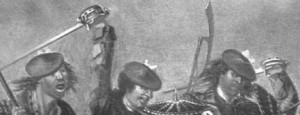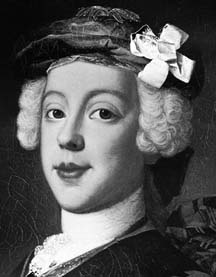Scots Bonnet Paper
BONNET & COCKADE
by
Terry Purke–April 1984
Dan Gilbert–January 1995
While there is evidence that bonnets were of several types–cut and sewn, knitted and woven–there is no need to make a big project out of this item. The standard Basque type beret available from hat shops, clothing stores and street vendors is perfectly acceptable. The dimensions should be 12-inches or more (you will have to search a little to find one this big but they are available) and the color should be blue–a royal blue or a shade lighter than navy blue. The modern military berets with the leather beading around the edge are not acceptable. (Directions for knitting a Scottish Bonnet)
You may sew a liner inside the hatband, but do not use dicing (checkered band) on the outside of the hatband. Dicing is of a later period. While “touries” or “pom-poms” are acceptable if they are small and unobtrusive, they are not necessary and are seldom seen in portraits of the period.
The effect you want is a flat pancake shape worn either straight across the forehead or at a rakish angle a la David Morier’s painting Culloden.

Detail from David Morier’s Culloden showing the Highlanders wearing their characteristic blue bonnets with white cockades. Morier was not at the battle; he painted the scene from descriptions and used Jacobite prisoners as models.
To this bonnet is affixed a white cockade, symbol of the House of Stuart. (The Hanovarians wore a black cockade to show their allegiance to King George.) The cockade is worn on the left side of the bonnet in the manner shown in the portrait of Bonnie Prince Charlie.
Detail from Bonnie Prince Charlie painted between 1739 and 1745. His blue bonnet sports the white cockade, a gold tassel tourie and a golden head band.
The cockade is made from 6 to 13 inches of white ribbon I to 1 inch wide and joined at right angles, forming an equilateral cross. The arms of the cross should be as long as the ribbon is wide. The two simple methods of construction are: (1) cut two 3-inch lengths and form a cross, forming a flat cross, or (2) fold a 13-inch length into a cross, forming a proper bow. You will probably want to throw in a few stitches to hold the cockade together. Then a few more stitches to fix the cockade to your bonnet.
REFERENCES:
—— Bonnie Prince Charlie (Pitkin Pictorals Ltd., Pride of Britain Books, London, 1973). The 2 paintings, Culloden and Bonnie Prince Charlie appear in this pamphlet. The original paintings are in the care of the Scottish National Portrait Gallery
BENNETT, Helen, Scottish Knitting (Shire Publications Ltd., Shire Album #164, England, 1986). This 32-page pamphlet has one of the best sections on bonnets and bonnetmakers.
Copyright Notice:
The Authors of these works retains full copyright for this material. Permission is granted to make and distribute verbatim copies of this document for non-commercial private research or educational purposes provided the copyright notice and this permission notice are preserved on all copies. All other rights reserved. The Appin Papers ™ is a trademark of the Appin Historical Society.
www.appins.org – Copyright 1998 and 2003, The Appin Historical Society.


